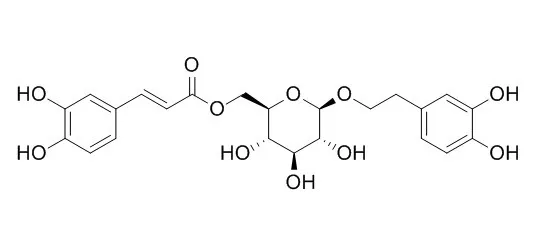| In vitro: |
| Chem Pharm Bull (Tokyo). 2014;62(3):288-93. | | Three new lignan glycosides with IL-6 inhibitory activity from Akebia quinata.[Pubmed: 24583784] |
METHODS AND RESULTS:
Three new lignan glycosides, akeqintoside A [(7S,8S)-7,8-dihydro-8-hydroxymethyl-7-(4-hydroxy-3-methoxyphenyl)-1'-benzofuranpropanol 2'-O-β-D-glucopyranoside] (1), akeqintoside B [(7R,8R)-7,8-dihydro-8-hydroxymethyl-7-(4-hydroxy-3-methoxyphenyl)-1'-(9'-methoxy-7'-propenyl) benzofuran 2'-O-β-D-glucopyranoside] (2), and akequintoside C [7R*,8R*-dihydroxy-7-(4-hydroxy-3-methoxyphenyl)-glycerol 9-O-β-D-(6'-O-caffeoyl)-glucopyranoside] (3) were isolated from Akebia quinata along with five known compounds, syringin (4), vanilloloside (5), salidroside (6), 3,4-dihydroxyphenylethyl alcohol 8-O-β-D-glucopyranoside (7), and Calceolarioside B (8). The structures of the compounds were identified based on one dimensional (1D)- and 2D-NMR, including (1)H-(1)H correlation spectroscopy (COSY), heteronuclear single quantum coherence (HSQC), heteronuclear multiple bond connectivity (HMBC) and nuclear Overhauser effect spectroscopy (NOESY) spectroscopic analyses.
CONCLUSIONS:
The inhibitory activity of these isolated compounds against interleukin-6 (IL-6) production in tumor necrosis factor-alpha (TNF-α) stimulated MG-63 cells was also examined. | | Biomed Res Int . 2017;2017:4273257. | | Inhibitory Activities of Stauntonia hexaphylla Leaf Constituents on Rat Lens Aldose Reductase and Formation of Advanced Glycation End Products and Antioxidant[Pubmed: 28326319] | | Abstract
Stauntonia hexaphylla (Thunb.) Decne. (Lardizabalaceae) leaves (SHL) have been used traditionally as analgesics, sedatives, diuretics, and so on, in China. To date, no data have been reported on the inhibitory effect of SHL and its constituents on rat lens aldose reductase (RLAR) and advanced glycation end products (AGEs). Therefore, the inhibitory effect of compounds isolated from SHL extract on RLAR and AGEs was investigated to evaluate potential treatments of diabetic complications. The ethyl acetate (EtOAC) fraction of SHL extract showed strong inhibitory activity on RLAR and AGEs; therefore, EtOAc fraction (3.0 g) was subjected to Sephadex LH-20 column chromatography, for further fractionation, with 100% MeOH solvent system to investigate its effect on RLAR and AGEs. Phytochemical investigation of SHL led to the isolation of seven compounds. Among the isolated compounds, chlorogenic acid, Calceolarioside B, luteolin-3'-O-β-D-glucopyranoside, quercetin-3-O-β-D-glucopyranoside, and luteolin-7-O-β-D-glucopyranoside exhibited significant inhibitory activity against RLAR with IC50 in the range of 7.34-23.99 μM. In addition, 3-(3,4-dihydroxyphenyl) propionic acid, neochlorogenic acid, and luteolin-3'-O-β-D-glucopyranoside exhibited the most potent inhibitory activity against formation of AGEs, with an IC50 value of 115.07-184.06 μM, compared to the positive control aminoguanidine (820.44 μM). Based on these findings, SHL dietary supplements could be considered for the prevention and/or treatment of diabetes complication. |
|






 Cell. 2018 Jan 11;172(1-2):249-261.e12. doi: 10.1016/j.cell.2017.12.019.IF=36.216(2019)
Cell. 2018 Jan 11;172(1-2):249-261.e12. doi: 10.1016/j.cell.2017.12.019.IF=36.216(2019) Cell Metab. 2020 Mar 3;31(3):534-548.e5. doi: 10.1016/j.cmet.2020.01.002.IF=22.415(2019)
Cell Metab. 2020 Mar 3;31(3):534-548.e5. doi: 10.1016/j.cmet.2020.01.002.IF=22.415(2019) Mol Cell. 2017 Nov 16;68(4):673-685.e6. doi: 10.1016/j.molcel.2017.10.022.IF=14.548(2019)
Mol Cell. 2017 Nov 16;68(4):673-685.e6. doi: 10.1016/j.molcel.2017.10.022.IF=14.548(2019)